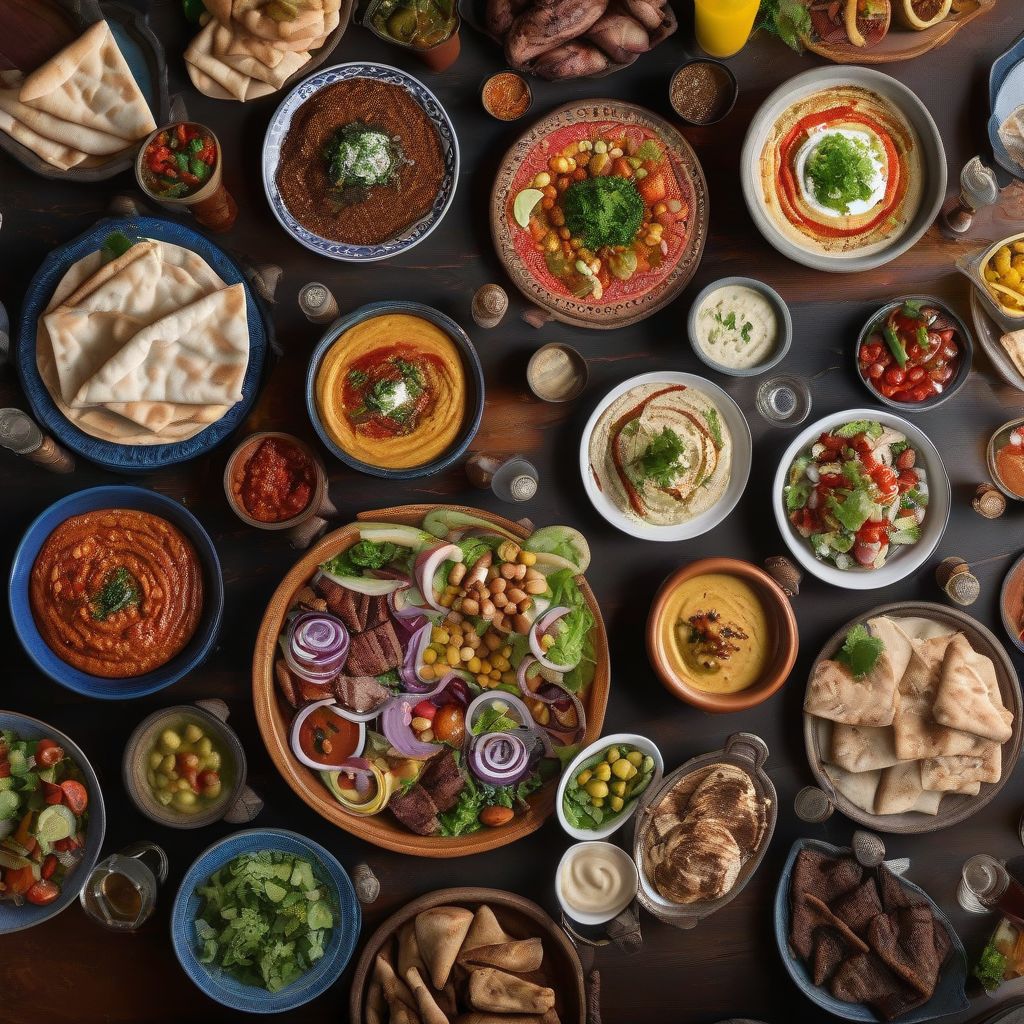Imagine biting into a warm, fluffy pita bread, the aroma of freshly baked spices filling your senses, or savoring a dish bursting with the vibrant flavors of the Middle East. You might think recreating these culinary delights at home is a challenge best left to the experts. But I’m here to tell you, it’s easier than you think!
As a nutritionist and meal prep coach, I’ve always been passionate about making healthy eating enjoyable and accessible. And nothing excites the taste buds quite like the bold, aromatic world of Middle Eastern cuisine.
In this comprehensive guide, we’ll embark on a journey to demystify the art of Middle Eastern cooking, equipping you with the knowledge and tools to create authentic, flavorful dishes in your own kitchen. We’ll explore essential ingredients, uncover helpful tips, and even provide some mouthwatering recipes to get you started.
Get ready to impress your family and friends with your newfound culinary prowess!
Delving into the Heart of Middle Eastern Cuisine
The beauty of Middle Eastern cuisine lies in its simplicity and emphasis on fresh, high-quality ingredients. Unlike some cuisines that rely on complicated techniques, Middle Eastern cooking is all about highlighting the natural flavors of each component.
Essential Ingredients: Building Blocks of Flavor
Before we dive into cooking, let’s take a look at the pantry staples that form the foundation of authentic Middle Eastern flavors:
- Spices: Warm, fragrant spices are the soul of Middle Eastern cooking. Think cumin, coriander, turmeric, cinnamon, cardamom, and allspice. These spices add depth, complexity, and a touch of magic to every dish.
- Herbs: Fresh herbs like parsley, mint, cilantro, and dill bring a refreshing vibrancy to the table. They are used generously in salads, sauces, and as garnishes, adding a burst of flavor and aroma.
- Legumes: Lentils, chickpeas, and fava beans are nutritional powerhouses and essential ingredients in many Middle Eastern recipes. They add texture, protein, and a satisfying heartiness to stews, soups, and salads.
- Grains: Rice, bulgur wheat, and freekeh are staple grains in Middle Eastern cuisine. They provide a versatile base for countless dishes and can be cooked plain or seasoned with aromatic spices.
- Tahini: This creamy paste made from sesame seeds is a true Middle Eastern gem. It forms the base of hummus, baba ghanoush, and adds a nutty richness to sauces and dressings.
- Olive Oil: High-quality olive oil is the cooking fat of choice in the Middle East. It adds a distinct flavor and is prized for its health benefits.
Mastering the Techniques: Your Gateway to Authenticity
While Middle Eastern cooking emphasizes simplicity, a few key techniques will elevate your dishes to the next level:
- Toasting Spices: Before adding them to your dishes, lightly toast whole spices in a dry pan to release their fragrant oils. This simple step intensifies their flavor and adds depth to your cooking.
- The Art of Rice: Rinse rice thoroughly before cooking to remove excess starch. Use the right water-to-rice ratio and experiment with different cooking methods, like the absorption method or the pilaf method, to achieve perfectly fluffy rice every time.
- Working with Phyllo Dough: This delicate, paper-thin dough might seem intimidating, but with a little practice, it’s easy to master. Use it to create crispy savory pastries like spanakopita or sweet treats like baklava.
Bringing the Flavors Home: Recipes to Delight Your Senses
Now that we’ve covered the essentials, let’s put our knowledge into practice with a few classic Middle Eastern recipes that are surprisingly easy to make:
1. Classic Hummus
This creamy chickpea dip is a Middle Eastern staple and a crowd-pleaser at any gathering.
Ingredients:
- 1 can (15 ounces) chickpeas, drained and rinsed
- 1/4 cup tahini
- 1/4 cup lemon juice
- 2 tablespoons olive oil
- 1-2 cloves garlic, minced
- 1/2 teaspoon cumin
- Salt and pepper to taste
- Paprika and chopped parsley for garnish
Instructions:
- Combine all ingredients except garnish in a food processor and blend until smooth and creamy.
- Adjust seasonings to taste.
- Transfer to a serving bowl, drizzle with olive oil, and sprinkle with paprika and parsley.
Tips:
- For extra smooth hummus, remove the skins from the chickpeas before blending.
- Add a tablespoon or two of ice water while blending for an even creamier texture.
2. Flavorful Chicken Shawarma
This popular street food dish features tender marinated chicken cooked to perfection and served in pita bread with your favorite toppings.
Ingredients:
- 1 pound boneless, skinless chicken thighs, cut into thin strips
- 1/4 cup olive oil
- 1/4 cup lemon juice
- 2 cloves garlic, minced
- 1 tablespoon ground cumin
- 1 tablespoon ground coriander
- 1 teaspoon paprika
- 1/2 teaspoon turmeric
- Salt and pepper to taste
Instructions:
- In a large bowl, combine all ingredients except chicken.
- Add chicken strips and toss to coat evenly. Marinate for at least 30 minutes, or preferably overnight.
- Heat a grill pan or skillet over medium-high heat.
- Cook chicken in batches, about 3-4 minutes per side, until cooked through.
- Serve in pita bread with hummus, tahini sauce, chopped tomatoes, onions, and pickles.
Tips:
- For a smoky flavor, grill the chicken skewers over charcoal.
- Don’t overcook the chicken, or it will become dry.
 Middle Eastern Dinner Spread
Middle Eastern Dinner Spread
3. Simple and Satisfying Tabbouleh
This refreshing salad is packed with fresh herbs, bulgur wheat, and a bright lemony dressing.
Ingredients:
- 1 cup fine bulgur wheat
- 1 cup boiling water
- 1 large bunch parsley, finely chopped
- 1/2 bunch mint, finely chopped
- 1/2 cup chopped tomatoes
- 1/4 cup chopped red onion
- 1/4 cup lemon juice
- 1/4 cup olive oil
- Salt and pepper to taste
Instructions:
- Place bulgur in a bowl and pour boiling water over it. Cover and let sit for 20 minutes, or until the water is absorbed and the bulgur is tender.
- Fluff bulgur with a fork and transfer to a large bowl.
- Add parsley, mint, tomatoes, and onion.
- In a small bowl, whisk together lemon juice, olive oil, salt, and pepper.
- Pour dressing over salad and toss to combine.
Tips:
- For a nuttier flavor, toast the bulgur lightly in a dry pan before adding the boiling water.
- Let the salad chill in the refrigerator for at least 30 minutes to allow the flavors to meld.
Embracing the Joys of Middle Eastern Cooking
Cooking authentic Middle Eastern meals at home is an adventure for the senses. It’s about embracing bold flavors, exploring new ingredients, and creating dishes that nourish your body and soul. With a little practice and a dash of culinary curiosity, you’ll be amazed at the delicious creations you can bring to your table.
So, gather your spices, chop your herbs, and let the aromas of the Middle East transport you to a world of culinary delights. And remember, the most important ingredient is always love!
Now that you’re equipped with the knowledge and inspiration, it’s time to embark on your own Middle Eastern cooking adventure. Don’t be afraid to experiment, get creative, and most importantly, have fun! What Middle Eastern dish will you be trying first?
[amazon bestseller=”middle eastern cookbook”]
